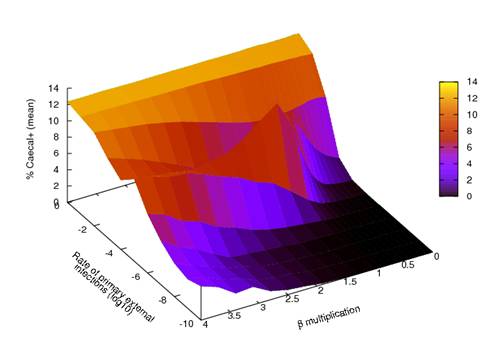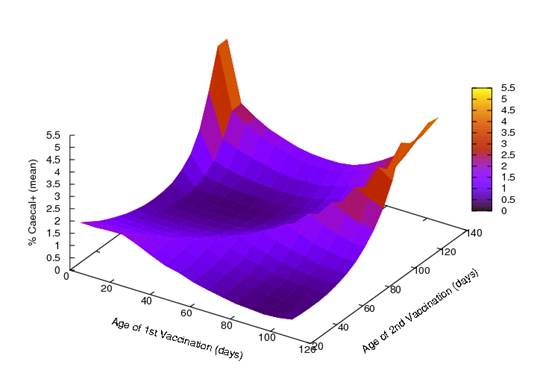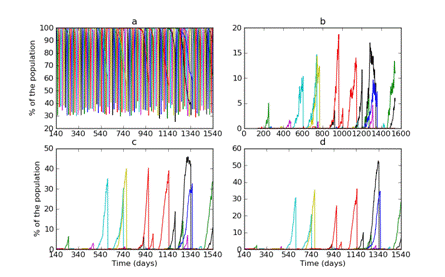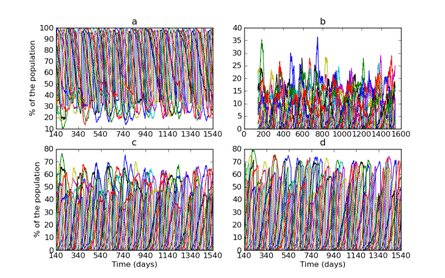Control Measures
Given the significance of Salmonella as a foodborne zoonosis, a lot of research has been conducted towards better understanding the key factors that affect the infection in the farm and reducing the levels of infection. Friendship et al. (2009) gathered all the available studies in a review study by that time and compared the results. According to this study the most important control measures are:
- Vaccination
- Probiotics
- Competitive Exclusion
- Genetic Resistance
- Sodium chlorate
- Acidification of Feed or Water
- Cleaning and Disinfecting
- Feed-related control
- Novel Strategies
Another study using mathematical modelling and the different mechanisms of action (Soumpasis et al., 2010) categorised and analysed the factors affecting Salmonella as follows:
- Sources outside the farm that are independent from the infection dynamics (external)
- Sources outside the room but inside the farm (pseudo-external) dependent on the force of infection of the other rooms
- Length of the fattening cycle and age of slaughter
- Cleaning and disinfection between the change of the batches of the pigs in a room
- Movements of pigs among rooms due to delayed growth or belligerence of some pigs
- Strategies that have an effect on the susceptibility of the individuals, e.g. parallel infections and feeding strategies
- Vaccination
According to the results, which come in agreement with the observed results from real life observations and explain them there are four categories of measures:
- Bio-security measures
- Measures with limited effect on Salmonella levels in the farm
- Measures the results of which depend on the level of Salmonella in the farm
- Vaccination.
These measures will be further analysed in the rest of this resource.
Bio-security measures
From the results of infection modelling and from the field observations it is clear that bio-security measures are the most important measures against Salmonella. As bio-security measures are considered all those measures that are taken towards reducing the probability and the rate of introducing the pathogen into a room from an external source.
In order to mimic farm dynamics for different categories of pigs researchers (Soumpasis et al., 2010) have used different levels of bio-security measures as inputs to their model to create 4 different type of farms that could match the Danish national Salmonella surveillance programme (Category 0 ("Negative"): <5%, Category 1 ("Acceptable, low"): 1%-40%, Category 2 ("Moderate"): 40%-70%, Category 3 ("Unacceptable"): >70% seropositivity)
(Alban et al., 2002b).
The results of running simulation scenarios of 10 cycles of 140 days each for a category 0 and a category 2 farm are presented in figure 6. The results are not surprising; in contrast they explain what happens in farms and the "unexplained" from time to time very positive samples from relatively "clean" farms. It is apparent that lowering the probability of introduction of Salmonella into a farm, there could still be from time to time some room infections, which could further be reduced with other measures. On the contrary, not keeping high standards of bio-security measures, there is a continuous infection in the farm - although silent - and taking other measures by their own would probably be of limited value.
Bio-security measures such as rodent control, barriers to protect from the ingress of animals and birds in the farm, disposable clothes for visitors, disinfection of the visiting vehicles and their wheels can reduce the probability and consequently the rate of introduction of the pathogen into the farm. Even areas around the farm houses, which are not regularly cleaned and Salmonella can survive for longer periods of time, can be considered as an external source of the pathogen, since once the pathogen is spread through manure and/or other means, it can be mechanically re-introduced with one of the above methods.
Some of the above bio-security measures, such as the rodent control, along with the overall good farming practices are able also to reduce the transfer of the pathogen from the other rooms of the farm to the room in question. Good farming practices can include the cleaning and disinfection of clothing and footwear or use of disposable ones, cleaning and disinfection of hands, tools, etc.
|
(A)
|
|
(B)
|
| Figure 6. Time course of Salmonella infections in a house with ten rooms in a Category 0 (A) and Category 2 farm (B). |
It is very important to understand that even in the cases of very high bio-security measures that reduce to minimum levels the probability of introducing the pathogen into the farm, if the within farm bio-security measures and good farming practices are not followed, Salmonella can still be a persistent problem because the pathogen is circulated very easily from one room to another which leads to low probability of disease extinction.
Measures with limited effect on Salmonella levels in the farm
The movement of pigs between rooms due to delayed growth or belligerence of some pigs seems to have limited effect on the fate of Salmonella in the farm. This result obtained using the modelling simulation is very well explained for two reasons. First, the number of moved pigs is usually limited and can hardly have an effect on the propagation of the pathogen. Second and most important, in order for this small number of pigs that are moved to have any effect, a large number of them must be infected in the first place. But in order for this to be achieved, there must be a serious breach of the bio-security measures beforehand, something which will have already more apparent effects on the infection of the farm.
Similar results were observed with the cleaning and disinfection of the rooms when they are empty of pigs. If the level of the infection is high, even if the rooms are totally disinfected, the pathogen will be quickly re-introduced from another source. However, this does not mean that cleaning and disinfection should be abandoned because still it reduces the levels of the micro-organism in the environment. Usually, it is considered under the bio-security measures or the good farming practices and in order to achieve these, the farm should be clean at the first place.
Measures the results of which depend on the level of Salmonella in the farm
The age of slaughter could vary depending on the future use of the pork product. Using computer simulation different slaughter ages ranging from 90 to 190 days were evaluated (Soumpasis et al., 2010). For most of the cases, the increase of the age of slaughter leads to a small parallel increase on the load of Salmonella at slaughter. However, for the case of category 0 farms the effect is opposite and very strong. Increasing the age of slaughter, reduces dramatically the prevalence of the pigs with Salmonella at slaughter age. These results are very important, as these types of farms represent in practice the majority of the pig farms that are infected with S. Typhimurium.
A side effect of this phenomenon is that it could jeopardise the Salmonella surveillance programmes of the farms and the estimation of the risk of introducing the pathogen into the slaughterhouse. For this reason, and in order for the results of the surveillance programmes to be comparable, it is suggested to monitor in parallel the age of the sampled pigs or to establish of a standard age for sampling.
Another very important issue is the existence of parallel infections that could affect the susceptibility of pigs against Salmonella. It is suggested that Lawsonia intracellularis or porcine reproductive and respiratory syndrome virus (PRRSV) may have an effect on the susceptibility of the animals (Beloeil et al., 2003). Except of the parallel infections, other factors could probably affect susceptibility of the pigs, such as the feeding strategy which could alter the intestinal environment, probiotics which could change the intestinal flora, or other strategies regarding husbandry.
However, no exact relationship has been developed so far between for any of these strategies and the susceptibility of the pigs or the load of Salmonella in farms. On the contrary often times, the results are quite contradictory especially when different studies are compared (Friendship et al, 2009).
These types of changes, which lead to the change of the susceptibility of the pigs to Salmonella, do have an effect on the transmission rate. Theoretically, increased susceptibility should lead to increased transmission rate and the lower susceptibility to lower transmission rate. Although this is clear, the expected prevalence of Salmonella at slaughter, which is actually what is measured in studies evaluating relevant factors, depends also on the level of infection of the farm at the first place.

Figure 7. Mean prevalence of the risk group with Salmonella at slaughter age versus the rate of external infections and the change of the transmission rate (multiplication factor from 0.1 times to 4 times of the original)
Indeed, except of the cases of very infected farms (category 3), where the effect of the transmission parameter is limited, changes of the transmission rate create unexpected results due to the dynamics that are developed (Figure 7). It is clear also from the figure, that if the transmission rate was zero, the high rate of introduction of the pathogen due to low bio-security measures would have kept the infection alive. On the other hand over-doubling of the transmission rate, will have as a result the infection to be surviving in the farm, even when extremely good bio-security measures are in place. A doubling of the transmission rate will mean in simple terms that an infected pig could infect four to five pigs during the shedding period.
It is clear that such strategies needed careful reviewing and understanding on the effect they really have in combination with other parameters involved in the transmission of Salmonella and that probably they should be combined with other more robust strategies such as bio-security measures.
Vaccination
Vaccination could be the final control strategy against Salmonella in pig farms. Although there are commercial vaccines available for S. Cholerasuis, there is no vaccine yet for S. Typhimurium. Moreover, the use of the S. Cholerasuis vaccine to pig farms infected S. Typhimurium was not very promising. Developing a new vaccine for a new pathogen or a new serotype, as in this case for S. Typhimurium, is a challenging process and a number of issues have to be taken into account. The application of the vaccination i.e. route of administration and the strategy would have to be evaluated through a cost-benefit analysis to determine if it should be used. Other complications, such as the probability of mutation and creation of more antibiotic-resistant strains or the difficulties that will arise in identifying in serological testing the vaccine from the wild strains, contribute to the difficulty of development of such a vaccine. The use of inactivated strains has shown that it does not have good results since it cannot create such a strong immunological response, if any. These vaccines generally are considered less efficient and need more doses to act.
In any case, the vaccination strategies can be tested using computer simulation, once the basic characteristics of the infection have been identified and reliable models have been built. Using an approach like this, Soumpasis et al. (2010) have developed a model that could be useful to test new vaccines for some given characteristics that it may have. The results of this could be useful to appreciate at the first phase if a vaccine can be useful, using an "optimum" vaccine.
The properties of the vaccine that can be used are the level of immunity that it creates, the length of the immunity, and the efficiency of the vaccination (as percentage of the vaccinated pigs that become protected). In this way, the vaccination strategy can be tested, in terms of one or multiple vaccination, optimal days for vaccination, percentage of pigs to be vaccinated etc.

Figure 8. Mean of the prevalence of the risk group with Salmonella at slaughter age versus the age of first and second vaccination for a category 2 farm
From the results of this study (Soumpasis et al., 2010), it was clear that using an optimum vaccine (100% efficiency, length of immunity as with wild types and level of immunity 100%), a double vaccination strategy was proposed to all the pigs. The results for a heavily infected (category 2) farm are shown in figure 8. The optimal dates for vaccination were the 4th and the 14th week of life after weaning.
For farms with higher loads of Salmonella the results were not that promising, stressing the
principle that vaccination on its own cannot make miracles, if it is not combined with bio-security measures. On the other hand, having in mind that there are very good results even in heavily infected farms such as the category 2, vaccination could be a good alternative control strategy if and when it is available.
Issues that must taken into account is the way of administration, e.g. it would be preferable to be an oral solution that could be mixed rather than one needing injection, because this would stress the animals and would be also much more costly. Moreover, it has to be kept in mind that there must be a way to distinguish between vaccine strains and wild strains when pigs are tested.

